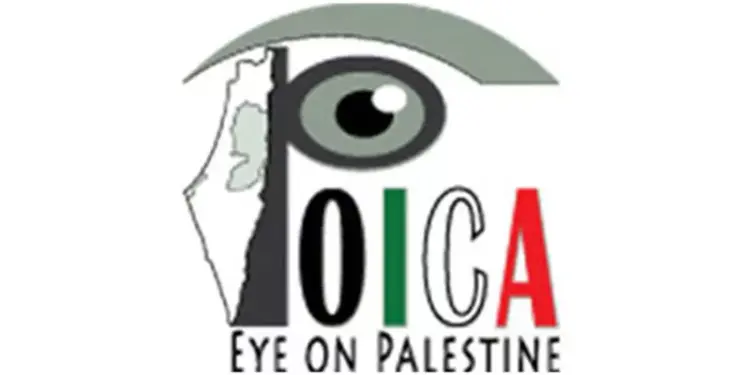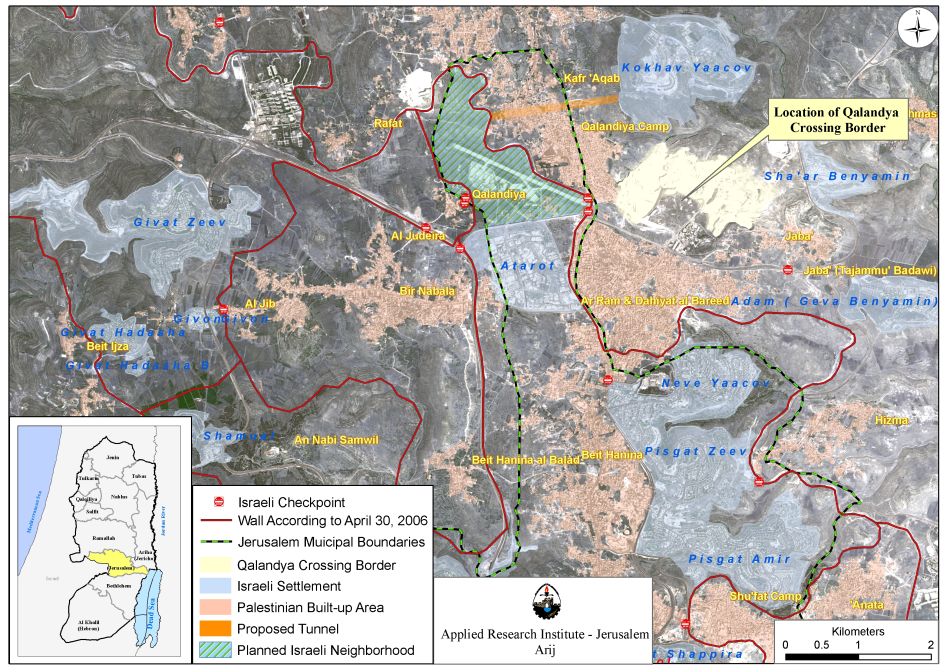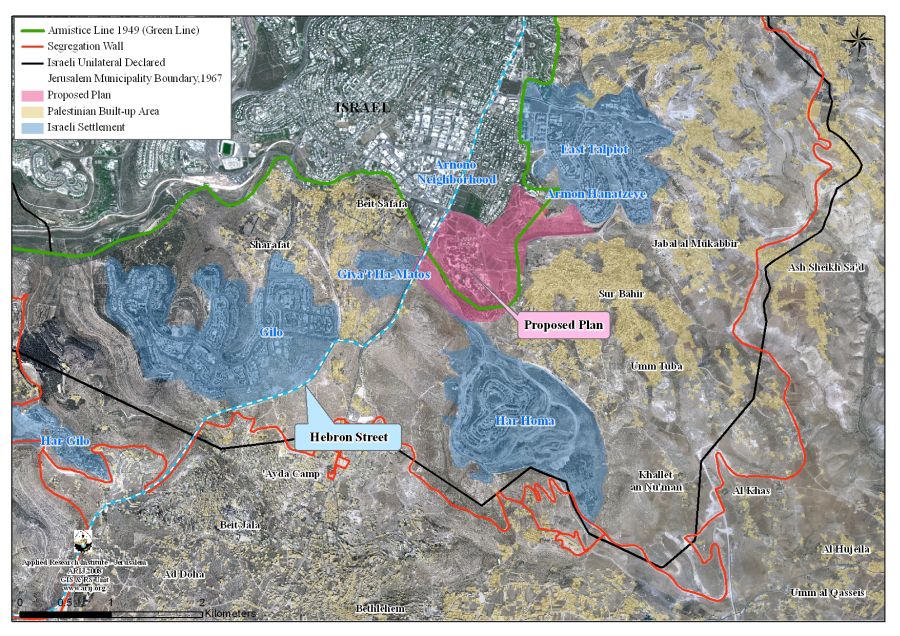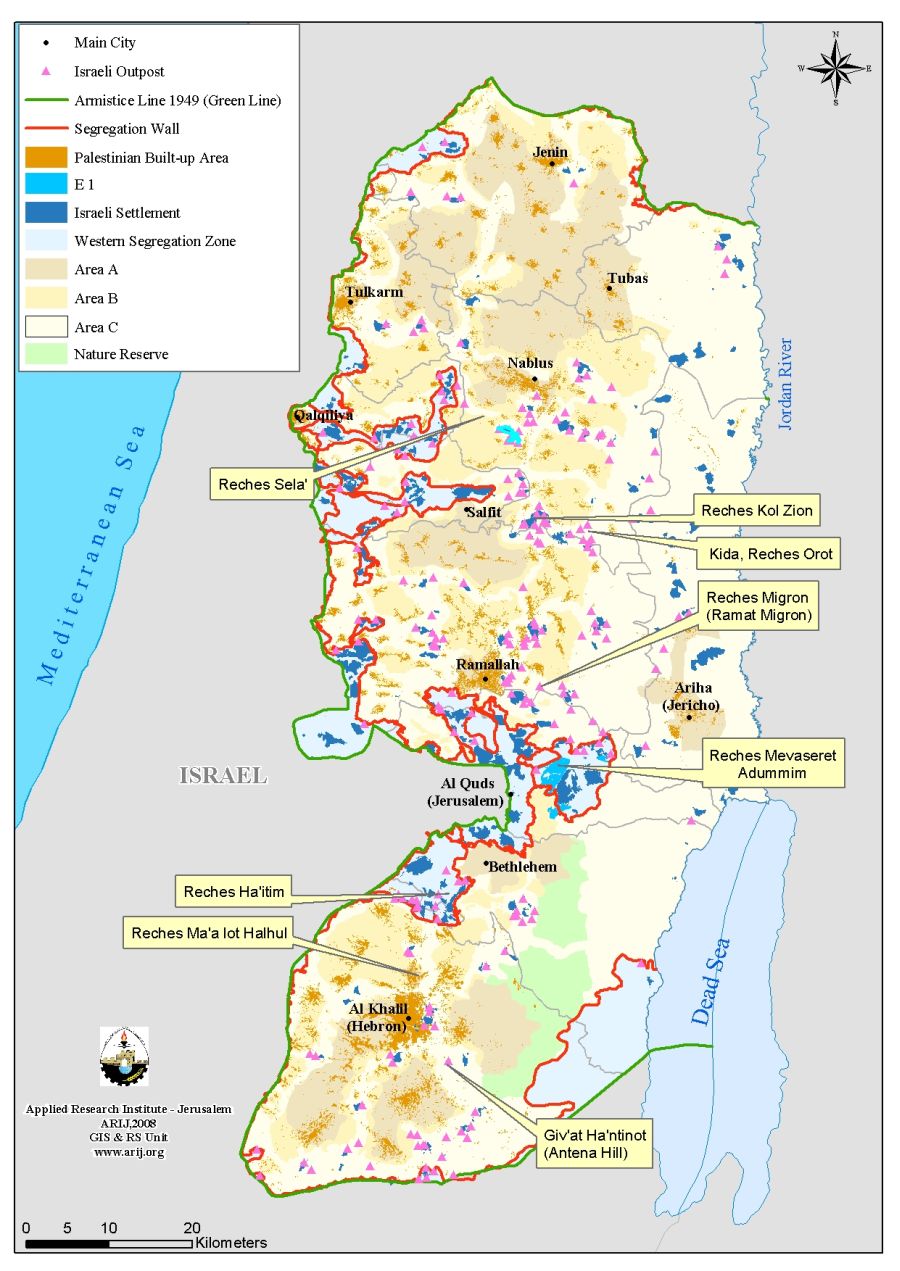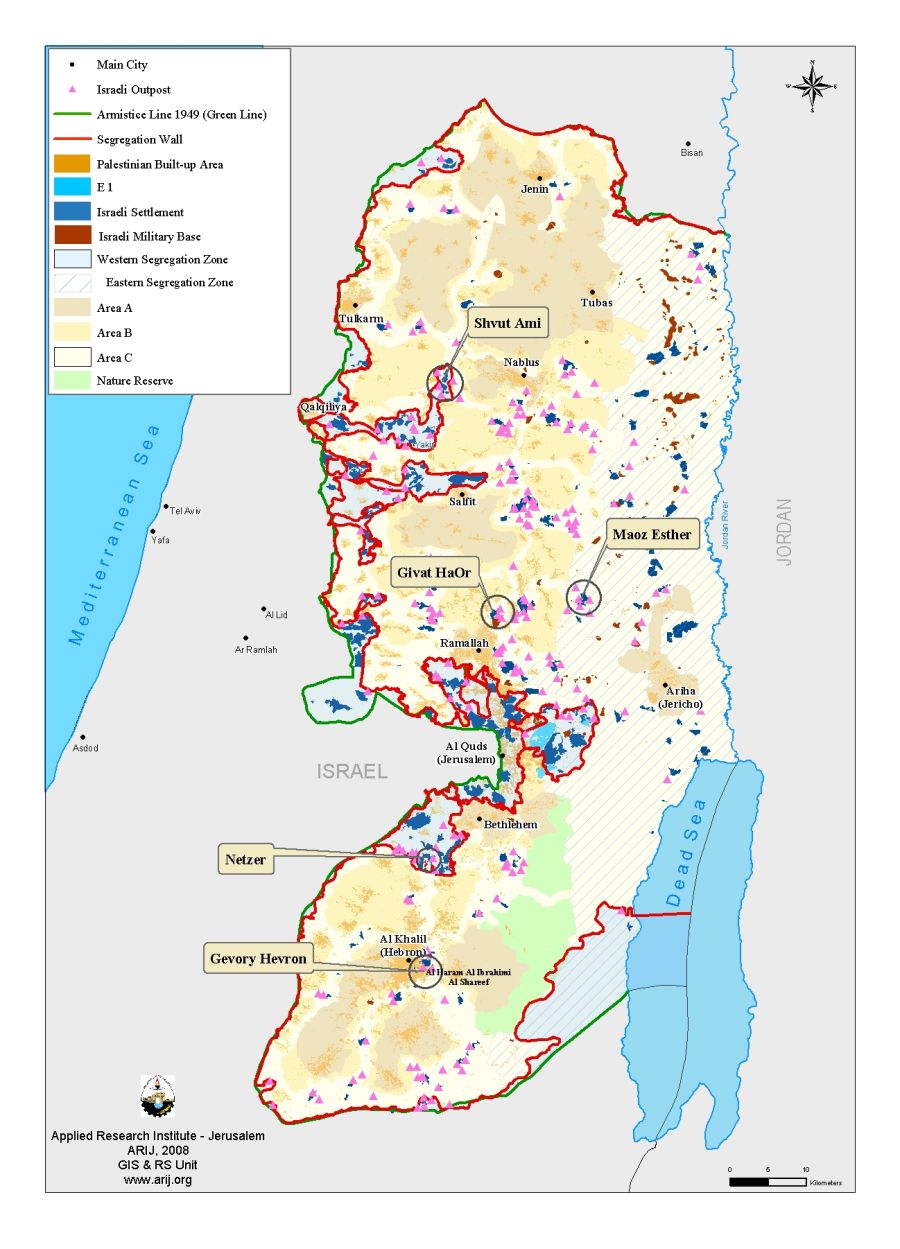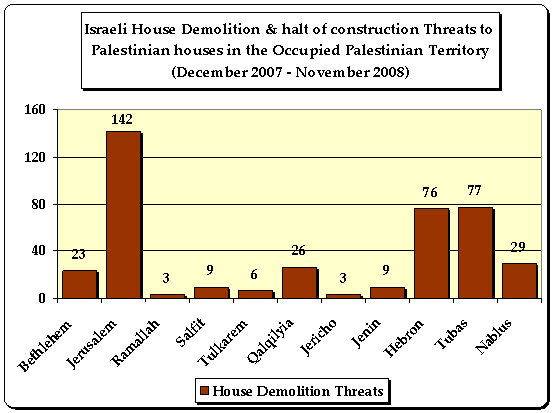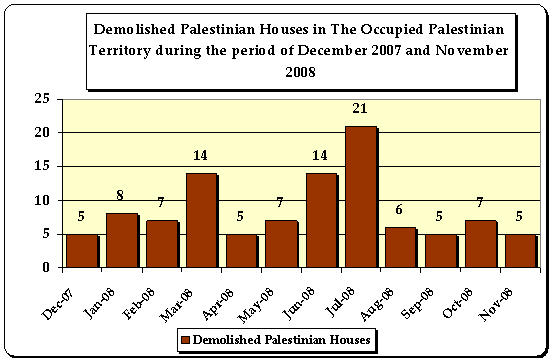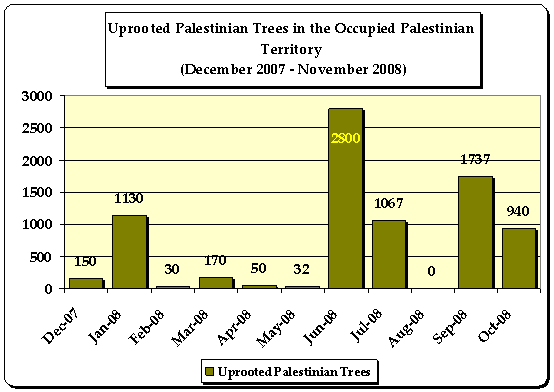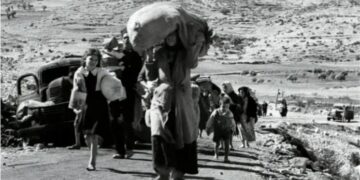One year after Annapolis Peace summit, during which the Palestinians and Israelis committed themselves to their obligations under the Road Map for peace, the construction of housing units in Israeli settlements in the Occupied Palestinian Territory have increased. Several statements and declarations were revealed either by the Israeli Municipality of Jerusalem city or by the Israeli Ministry of Housing & Construction and the Israeli Land Administration, which included bids and plans to add thousands of housing units to Israeli settlements in the occupied West Bank and most of them, were in settlements within the city of Jerusalem. The following is a detailed list of the Israeli bids and plans that have been announced by the Israeli municipality of Jerusalem since Annapolis conference:
December 2007
-
On December 4, 2007, the Israeli Ministry of Housing and Construction submitted a tender to build 307 new Israeli housing units in the controversial Har Homa settlement which lies at southeastern edge of Jerusalem city, just under two kilometers north of the city of Bethlehem. This announcement was followed by another one on the 15th of December 2007, by the Israeli Ministry of Interior to build 150 new housing units in Jabal Al Mukkabir inside the illegally redrawn Jerusalem Municipal boundaries.
-
On the 19th of December 2007, the Israeli minister of housing and construction gave the green light to commence the construction of the new neighborhood in east Jerusalem close to Qalandyia airport, in Atarot area. The new neighborhood will include the construction of 11000 housing units which is considered 'the largest' Jewish neighborhood to be constructed on the lands of the Illegal redrawn municipal boundary of Jerusalem city following the 1967 war as conceived by planners.
-
On the 23ed of December 2007, the Israeli Ministry of Housing and Construction announced that it will allocate a total of 18 Million euros from its budget for the year 2008 to expand Ma'ale Adumim and Har Homa settlements. The plan will include the construction of 500 housing units in Har Homa settlement and 240 housing units in Ma'ale Adumim settlement.
-
On December 23, 2007, the Israeli Land Administration (ILA) revealed its proposal-plan to construct several hotels buildings in Gilo settlement located south of Jerusalem City on six dunums of land, with an option to turn these hotels plans to residential buildings when needed.
-
The Israeli Civil Administration issued on the 30th of December 2007 a tender to build 440 housing units in Armon Hantsef Neighborhood in east Telpiot settlement south of Jerusalem city on lands of Sur Baher and Jabal Al Mukkabir Communities. It is worth mentioning that the plan was given a priminilary approval by the Israeli Government in April 2005.
January 2008
-
On January 8, 2008, the Israeli Jerusalem Municipality has approved a plan to add 60 new housing units to Ma'aleh Zeitim Jewish quarter in the Palestinian Ras Al ‘Amoud neighborhood in East Jerusalem city where 51 Jewish families currently live. These families were brought into the place some 15 years ago with the support of the Jewish-American 'Irwing Meskovetch' (in California: AKA; Bingo King) who claimed his ownership of the lands at that time. The construction process went into operation a week later on January 15, 2008.
-
On January 29, 2008, a Jewish right wing organization (Nahlat Shim'on) announced about plans to add 200 new housing units to Shim’on Tsedeq in Al Shiekh Jarrah neighborhood in east Jerusalem. About forty Palestinian families live in the area where their houses are threatened of demolition as to make room for the construction of the 200 units. The new plan is expected to be constructed on 18 dunums of lands. The neighborhood is currently inhabited by 7 Jewish families.
-
On January 23, 2008: The Israeli Ministry of Housing and construction, along with the Israeli Municipality of Jerusalem decides to resume construction in East Jerusalem settlements under what it claims natural growth as reported by Israeli Channel 2. The decision was to add 7300 new housing units in five Israeli settlements located within Jerusalem Municipal Boundary. The settlements are Har Homa (1000), Gilo (3000), Pisgat Ze'ev (1700), Neve Yacoov (400) and Ramot (1200).
-
On its website, the Israeli Municipality of Jerusalem revealed on the 23ed of January 2008, a plan to build an overall 40,000 new housing units in Jerusalem city under what it calls a 'house for each worker.' The website also shows that 8,000 units have already been sanctioned, thus presenting the asymptotic between the two numbers 7,300 and 8,000.
March 2008
-
On March 10, 2008, the Israeli Minister of Housing and construction issued tender to construct new housing units in a number of Israeli settlements in the West Bank. The settlements are: Pisgat Ze'ev settlement north of Jerusalem city (750 housing units), Giv'at Ze'ev settlement northwest of Jerusalem city (750 housing units), Har Homa settlement south of Jerusalem city (360 housing units), Ma'ale Adumim settlement east of Jerusalem city (52 housing units), Ikana settlement south of Qalqilyia city (52 housing units) and Efrata settlement southwest of Bethlehem city (80 Housing Units).
-
The Israeli Municipality of Jerusalem announced on the 10th of March 2008 about plans to add 400 housing units in Neve Yacoov settlement northeast of Jerusalem city.
-
The Israeli Shas party announced on the 12th of March 2008 about plans to build 800 new housing units in Kidmat Zion neighborhood east of Jerusalem city on lands of Abu Dis community. At the same time, the Israeli Ministry of Housing and construction announced about plans to build 288 new housing units in Elkana settlement south of Qalqilyia city.
-
On the 5th of March 2008, The Israeli regional committee for planning and construction published plans to build 2337 new housing units in Giv'at Hamatos settlement south of Jerusalem on 411 dunums of lands of Beit Safafa community. Some buildings will be composed of 5 floors.
-
On March 17, 2008, the Israeli Occupation Authorities set plans to build new housing units in Ariel settlement north of Salfit city. The IO authorities also announced about plans to built 89 new housing units in Ma'ale Adumim settlement east of Jerusalem city in addition to 32 housing units in each of Betar Illit, Sha'are Tekvah and Elakan settlements.
-
On March 22, 2008, the Israeli Ministry of Housing and Construction announced about plans to build a new neighborhood in Efrat Settlement southwest of Bethlehem city composed of 54 housing units and parking alot.
-
On March 23, 2008, the Israeli Minster of Defense announced about plans to build 80 new housing units in Ele'zer settlement southwest of Jerusalem city.
-
Yahudat Ha Torah Jewish organization announced on the 25th of March 2008 its full support to the Israeli Government's decision to develop Betar Illit settlement located west of Bethlehem city through the construction of 800 new housing units in the settlement.
-
The Israeli Civil Administration approved on the 31st of March 2008 the construction of a new neighborhood in Modi'in Illit northwest of Ramallah city which will be composed of 78 residential buildings. Each building will include 8 apartments in the first phase and 4 apartments in the second phase.
-
The Israeli Municipality of Jerusalem approved on the 31st of March 2008 the construction of 600 new housing units in Pisgat Ze'ev settlement located north of Jerusalem city.
April 2008
-
On April 21, 2008, the Israeli Municipality of Jerusalem approved the construction of 400 new housing units on lands of Qalandyia village north of Jerusalem city. The units are part of a larger Israeli settlement project which will be constructed in the area and within the illegally redrawn Jerusalem Municipal boundaries and include the construction of 11000 new housing units.
-
On the 28th of April 2008, a group of Jewish settlers from 'Redeeming Jerusalem' committee coercively took residency in the former building of the Police Station in Ras Al 'Amoud neighborhood after the Israeli police vacated the building and moved into the new Police headquarter in the controversial E1 area in Ma'ale Adumim settlement bloc. The neighborhood will comprise of 110 housing units over 10 dunums of vacated land in addition to 6 Israeli societies and public organizations. The site of the old police station will be the nucleus of a new Israeli settlement in Ras Al 'Amoud area called 'Ma'ale David.
May 2008
-
Israeli sources revealed plans on the 2ed of May 2008 to build 395 new housing units in Nof Zion settlement in East Jerusalem on 44 dunums of lands of Jabal Al Mukkabir. In addition, public buildings, a synongue, a commercial center and a kinder garden will be build in the settlement.
-
On the 4th of May 2008, the Israeli Ministry of Housing and Construction announced about plans to build 600 new housing units in Betar Illit settlement located west of Bethlehem city.
-
The Israeli committee for planning and construction at the Jerusalem Municipality announced on the 13th of May 2008 to build 150 new housing units in Gilo settlement north of Bethlehem city. Each building will be composed of 12-14 appartments on 20 dunums of land. At the same time, the Israeli Ministry of Housing and construction announced about plans to build 229 new housing units in Har Bracha settlement located south of Nablus city north of the West Bank.
-
The Israeli Prime Minister Ehud Olmert approved on the 21st of May 2008 the construction of 286 new housing units in Betar Illit settlement west of Bethlehem city.
-
Group of Israeli settlers from 'Khade Ya’lez' movement announced on the 26th of May 2008 that they are planning to construct a new neighbourhood (Qiryat Ya’lez) in Giva’t Ze'ev settlement located northwest of Jerusalem city which will be composed of 300 housing units.
-
On May 31, 2008: The Israeli Minister of Housing and Construction 'Ze'ev Boim' announced that new tenders to be issued soon to construct hundreds of housing units in two settlement inside Jerusalem city. The plan tender will include 121 units in Har Homa settlement located south of Jerusalem City and 763 units in Pisgat Ze'ev settlement located north of Jerusalem city.
June 2008
-
The Israeli Committee for planning and construction at the Jerusalem Municipality announced on the 6th of June 2008 about a new plan to build 850 new housing units in Gilo settlement south of Jerusalem city. The plan which was proposed to the Municipality of Jerusalem on May 28, 2008, holds number 13157 and will be implemented in Gilo's western part opposite to Al Walajeh village west of Bethlehem city.
-
The Israeli regional committee for housing and planning agreed on the 13th of June 2008 to construct 1300 new housing units in Ramat Shlomo settlement near Beit Hanina and Al Isawiyeh communities in Eastern Jerusalem.
July 2008
-
The Israeli regional committee for planning and construction endorsed on the 10th of July 2008 the construction of a new neighborhood in Har Homa settlement from its southeastern side. The neighborhood will include the construction of 910 housing units on 300 dunums of Palestinian lands. The committee also endorsed the construction of 900 housing units in Pisgat Ze'ev north of Jerusalem city on 140 dunums of land.
-
The Israeli daily newspaper, Haaretz, published on the 24th of July, 2008 that the Israeli Defense Ministry along with the Israeli Civil Administration are planning to activate a part of a development plan in Masskiyot settlement in the Northern Valleys which includes the construction of 20 new housing units out of 180 units that were slated to be built in the settlement during the year 2006, to accommodate more Israeli settlers there.
-
On July 28, 2008: The Israeli government is preparing to launch a project in Kedar 'B' settlement southeast of Jerusalem city, located within Ma'ale Adumim settlements' Bloc. The project includes the construction of 6000 housing units in the aforementioned settlement and will be put forward for discussion and planning during the first week of August 2008. The Kedar project aims at linking Kedar 'B' Settlement with its neighboring mother settlement 'Kedar' to ensure the contiguity of Ma'ale Adumim settlements and the annexation of the bloc to Jerusalem city and to Israel upon the completion of wall construction around Jerusalem.
August 2008
-
The Israel Land Administration and the Israeli Ministry for Housing Ministry issued tenders on the 2ed of August 2008 for building 735 new housing units in Pisgat Ze'ev settlement north of Jerusalem city. At the same time, the Israeli Land Administration gave the green light to build 130 new housing units in Har Homa settlement north of Bethlehem city.
-
On August 8, 2008, the Israeli Occupation Authorities issued tenders for 316 new housing units in Betar Illit settlement west of Bethlehem city.
-
On August 20, 2008: The Israeli Regulation committee from planning and construction in Jerusalem city ratified a scheme to build hundreds of housing units in Neve Yacoov settlement north of Jerusalem. According to the scheme, the municipality will build 400 housing units on 80 dunums of lands.
September 2008
-
On September 9, 2008: The Israeli civil administration issued a tender to build 32 housing units in Betar Illit settlement located southwest of Bethlehem city. The tender is a continuation to a previously issued tender which stated the construction of 286 units in the settlement.
November 2008
-
On November 8, 2008, The Preservation of Nature Company in Israel proposed a plan to construct a new neighborhood close to Kebutz Ramat Rahel north of Har Homa settlement, on an area located between east Telpiot and Gilo settlements. The neighborhood is to include the construction of 4690 new housing units for young couples over 1588 dunums of lands. The plan will come on a huge portion of land of Sur Baher community located southeast of Jerusalem city.
Based on the analysis conducted by the Applied research institute – Jerusalem (ARIJ) showed that most of the plans and tenders that were issued by the Israeli Occupation Authorities and the various Israeli Ministries were concentrated in Bethlehem and Jerusalem Governorates as 76% of the total number of housing units were issued in Jerusalem Governorate and 23% in Bethlehem Governorate. This highlights the Israeli Government's intention to :
1. Reform the demography of the city by increasing building inside it to bring more Israeli settlers to live in the city,
2. To ensure that the number of Palestinians would not exceed one quarter of the total number of population in the city of Jerusalem (Both east and west)
3. To reform the geography of the city to what suits the Israeli Segregation plans and the isolation of Jerusalem city from the rest of the West Bank Governorates this in turn will undermine the prospect of a contingent Palestinian state with Jerusalem as its capital.
The erection of New Israeli Outposts in the Occupied Palestinian Territory
-
A group of Israeli settlers announced about the erection of two new outposts in Ramallah and Bethlehem Governorates, the first close to Pesagot settlement east of Ramallah city and the second near Efrata settlement southwest of Bethlehem city.
-
On the 9th of December 2007, the 'Land of Israel Faithful' organization, 'Youth for Eretz Yisrael', and Women in Green and the local grassroots action committees announced about plans to erect 12 new outposts in the Occupied West Bank
|
Table 1: Distribution of Israeli Outposts in the West Bank |
||
|
Governorate |
Israeli Outpost |
Israeli Settlement |
|
Nablus |
Reches Sele' |
Bracha |
|
Har Chivi |
Alon Moreh |
|
|
|
Mo'az Ester |
Kochav Hashahar |
|
Giv'at Ha'or |
Beit Il |
|
|
Novei Hashmona'im |
Hasmona'im |
|
|
Salfit |
Shevut 'Ami |
Kedumim |
|
Bethlehem |
Netzar |
Alon Shevut |
|
Giv'at Haeitim |
Efrata |
|
|
|
Mevaseret Adumim |
Ma'ale Adumim |
|
Reches Migron |
Kochav Ya'acov |
|
|
Sha'are Ha Mezrach |
Pisgat 'Amir |
|
|
Hebron |
Ma'a lot Halhul |
Kiryat Arba' |
Map 1: List of Israeli outposts to be reconstructeed
Map 2: Locations of new outposts
-
On October 21, 2008: In what has become something of a Jewish holiday tradition,IsraeliRight wing settlers reoccupied four locations in the West Bank. The locations are: Reches [Hilltop] Sela', Maalot [Steps] Halhoul, Reches [Hilltop] Migron and Sha'are Hamezrach (The Eastern Gate). The four outposts were evacuated by the Israeli Occupation Army during the same day, but the settlers intend to go back and rebuild them.
-
On March 18, 2008: the Israeli settlers of Eli'zer settlement located southwest of Bethlehem city constructed a 100 m² house on lands of Muneir Hussein Musa in Al Dahr area in Al Khader village in an attempt to construct an outpost on his 14 dunums land and expand the exiting settlement.
-
On April 8, 2008, the Israeli Haaretz Daily newspaper published that a group of the Israeli right wing activists called 'Developing Har Shamuel Settlement' along with settlers of the Gush Etzion regional council are planning to establish a new Israeli outpost on remains of an evacuated Israeli military base east of Beit Sahour.
-
On May 19th, 2008, Ynetnews, the Israeli online news website, reported that a new outpost had recently started development on a hill near the settlement of Neguhot in South Mount Hebron. With two of the three hills already occupied by settlers, the permanent structure that marked the beginning of a new outpost is set on the third and final hill in the Neguhot settlement area.
-
On July 7, 2008, the Israeli Occupation Forces erected five new caravans in an Israeli outpost located west of Karmei Zur settlement between Halhul and Beit Ummar towns.
-
ON the 12th of August, Israeli Settlers from rightist organizations and movements attempted to establish a new outpost on the hill adjacent to the Palestinian Shu'fat refugee' camp and at a distance of half a kilometer from the French Hill settlement in East Jerusalem. The Area where settlers intend to possess an estimated 180 Dunums, adjacent to Palestinians houses in Shu'fat refugees' camp, the settlers called the new outpost Shar Hamizrach (The Eastern Gate). The area in question is considered to be strategic for the settlers since it lies near the bypass road number one, which links Ma'aleh Adomim to Jerusalem, and along the controversial E1 area where the Israeli settlement council of Ma'ale Adumim plans to build 3500 housing units.
Israeli House Demolition Policy in the Occupied Palestinian Territory
At the time the Israeli Occupation Authorities gave the green light to the construction of hundreds but thousands of housing units in Israeli settlements in the Occupied West Bank, it intensified its house demolition policy in the territory. Since Annapolis summit which was held on the 26th of November 2007, Israeli has demolished 104 Palestinian houses in the West Bank Governorates mostly conducted under the pretext of lacking valid building permits. Israel has always taken the 'pretext of illegal construction' an excuse to continue its violation of international laws and the displacement of Palestinians from their homes and lands to fulfill it colonial ambitions in the territory. Graph 1 shows the number of Palestinian homes that were demolished in the occupied West Bank: —
Jerusalem Governorate comes in the first place in terms of the number of houses demolished during the aforementioned period (approximately 60 Palestinian Houses of the total demolished houses) as the Israeli government seeks through its policies to empty the city of Jerusalem from its original land owners, through the demolition of homes and imposing restrictions on them, revoking their Jerusalem identities, and unbalancing of the demographic status in the city for the sake of Israeli settlers.Hebron Governorate comes in the second place were 22 Palestinian houses out of the total number (104) were demolished in the Governorate.
Israeli has also handed over more than 400 house demolition and halt of construction threats to Palestinians in the Occupied Palestinian Governorates which also threatens many Palestinian families of displacement. Graph 2 below details the distribution of Houses demolition and halt of construction threats that were issued during the period of November 26, 2007 & November 2008.
Israeli Military Orders in the Occupied Palestinian Territory after Annapolis
The Israeli occupation Authorities continue to issue military orders confiscate more Palestinian lands for various military purposes, which included building of new sections of the Israeli Segregation Wall in the West Bank, building of military towers to tighten the siege on Palestinians, the expansion of Israeli military checkpoints and Israeli settlements and other excuses. The following is a summary of all the Israeli military orders that were issued in the period between December 2007 and November 2008: —
|
Issued Israeli Military Orders following Annpolis summit. |
||||
| Date | MilitaryOrder No. | Area (Dunum) | Location | Purpose |
| 8/1/2008 | ( 41/07/T ) | 9 | Mas-ha and Az Zawiya | To construct a bypass Road |
| 21-1-2008 | ( 51-05-B),( 10-05-(B, (43-05-(B,( 46-05-(B,( 47-05-B) | 72.2 | Al Jab'aa and Wadi Fukin | State Land |
| 24-2-2008 | (183-5-T) | 860 | Ad Dhahriya and Dura towns south of Hebron city | To build a security fence around Eshkolot settlement |
| 29-4-2008 | 08-06-T | 20 | Ni'lin Village | To construct Kiryat Sefer Terminal |
| 1/5/2007 | (5730-1970) | —– | Zuwwata, Qusin, Nablus city, Beit Iba, Beit Wazan, Azmout, Al Juneid, Deir Al Hatab, Salem, Sara, Askar Camp, Balata Camp, Tel, Iraq Burin, Rujeib and Kafr Qalil. | Siege Area |
| 18-5-2008 | 79-08 | 25 | Al Isawiyeh town southeast of Jerusalem city | to construct a section of the Israeli Segregation Wall |
| 16-6-2008 | 08-08-T | 356 | Samra Hamlet east of Tubas city | —– |
| 1/7/2008 | (E/M/9) | — | Al Bustan Neighborhood in Silwan city | demolition of 100 houses |
| 9/7/2008 | (16/08/ت) | 6 | Rummana village west of Jenin city | Expansion of training base located close to Salem Camp |
| 15-8-2008 | 94-05-T | 1.5 | Tel Ar Rumeida | To construct a military Road |
| 15-8-2008 | — | 92 | Al Khader Village west of Bethlehem city | Expansion of Efrata settlement southwest of Bethlehem city |
| 21-9-2008 | 08-05-T | 33 | Yatta townsouth of Hebron city | to add new wall sections in the area |
| 22-9-2008 | (06/08/T) | 6.5 | Ramin village east of Tulkarem city | To Expand Enav military Checkpoint |
| 2/9/2008 | ( 08/ 19/T) | 427 | Jayyus and Falamiya villages | to ammend the path of the Israeli Segregation Wall |
Source: ARIJ Military Orders Database – 2008
Details of Israeli Military Orders:-
-
On January 8th, 2008 Israeli occupation authorities declared its intention of confiscating 9 agricultural dunums in the villages of Masha and Al Zawiya. The confiscation order held the number T/41/07 and states the confiscation of land for the establishment of a new agricultural road.
-
On January 21, 2008, the Israeli Custodian of Absentee Land Property in the Israeli Army handed out Palestinian farmers from Al-Jaba’a and Wadi Fukin villages southwest Bethlehem Governorate 5 military orders holding numbers 46/05/B, 47/05/B, 10/05/B, 43/05/B, 12/05/B to evacuate their lands and to remove and dismantle all what exists on the land point out in the warning notices; this includes but not limited to trees, infrastructure installations, or anything else, under the pretext that the lands area is “State Land.” Lands in questions are estimated at 72.2 dunums. to evacuate their lands and to remove and dismantle all what exists on the land point out in the warning notices; this includes but not limited to trees, infrastructure installations, or anything else, under the pretext that the lands area is “State Land.” Lands in questions are estimated at 72.2 dunums.
-
On February 23, 2008, the Israeli Army handed out residents of Ad Dhahryieh and Dura towns located at the southern part of Hebron Governorate an amendment-addition to a previously issued military order number (05/183/T), which states the confiscation of 766 dunums of lands from the two communities. The military order was issued under the claim of military uses to construct a security fence (part of the Segregation Wall) around Eshkolot settlement located in the southwestern part of Hebron Governorate.
-
On April 16, 2008, the Israeli Chief Commander of the West Bank Jad Shemny Alof handed out residents of Ni’lin village west of Ramallah governorate; a military order holding # (06/08/T) informing them that 18.9 dunums of their lands will be confiscated to construct what is called 'Qiryat Sefer” terminal. Lands stated for confiscation order lie in Bloc 9 in the areas of Al Jourus, ‘Aqabat Beir Rein and Batin Al Jaher. According to the analysis done by the Geographical Information Unit (GIS) at ARIJ, the military order will confiscate 61 dunums of lands from the village, which contradicts what the Israeli Army’s confiscation order of 18.9 dunums.
-
A new Israeli military order signed by the commander of the Israeli defense forces in Judea and Samaria, major General Ya'eir Neve Alof, on the 19th of April 2007, (Order with regard to security instruction 'Judea and Samaria' number 378 of the year 1970) officially declares Nablus city and 15 other Palestinian villages around it as 'Siege Area'. The order also assigned 6 main Israeli checkpoints (crossing points) to control the ins and outs of Palestinians living in those 16 communities. The 'siege area' includes the following communities: Zuwwata, Qusin, and Nablus city, Beit Iba, Beit Wazan, 'Azmout, Al Juneid, Deir Hatab, Salem, Sarah, Askar Camp, Balata Camp, Tal, Iraq Burin, Rojeib and Kafr Qalil. The 15 villages and Nablus city houses a total population of more that 220 thousand Palestinians.
-
On May 18, 2008,the Israeli Defense Ministry issued a military order number (79-08) to confiscate 25 dunums of Palestinian lands in Al ‘Isawiya town northeast of Jerusalem city to construct a security fence in the eastern part of the town.
-
On June 16, 2008, the Israeli Occupation Authorities handed out residents of Kherbit Samra east of Tubas city military order # 08/08/T to confiscate 356 dunums of lands to construct a new military base in the area.
-
On July 1, 2008, The Jerusalem Municipality announced its willingness to revive plan number (E/M/9) to demolish 100 Palestinian houses in Al Bustan neighborhood in Silwan city south of Jerusalem city.
-
On July 9, 2008, the Israeli Chief Commander of the West Bank Jad Shemny handed out residents of Rummana village northern of Jenin governorate; a military order holding # (08/16/T) informing them that 6 dunums of their lands will be confiscated for military uses in order to expand a shooting field for the Israeli army near Salim military camp.
-
On August 15, 2008: The Israeli Occupation Authorities issued a new military order number (T/5/94) which states the seizing of 1.5 dunums of Tal Al-Rumeida neighborhood in Hebron city. The Military Order aims to establish a road for military purposes in the area
-
On August 15, 2008: The Israeli Land registration office at the Israeli Civil Administration declared the confiscation of 92 dunums of Agricultural lands under the pretext of being classified as “State Land”. The Confiscation order comes to fulfill the Israeli plan to expand Efrat settlement located to the southwest of Bethlehem city.
-
On the 11 of August 2008, the Israeli military Authorities handed our residents of Ramin village east of Tulkarem city a military order number (06/08/T) stipulating the confiscation of 6.5 dunums of lands of Ramin village for the use of military purposes, mainly to expand Enav military checkpoint located to the west of the village.
-
The Israeli Occupation Forces handed over the villages of Jayyus and Flamyia, located northwest of the town of Qalqilyah, military order on the 2ed of September 2008 to seize 427 dunums and 100 meters of land to modify the route of the wall primarily along the western part of the two villages. Palestinian citizens were handed over the military order two weeks after the issuance date of the military order and the objection period is over. The Israeli Occupation forces made an amendment to the western section of the Wall in the two villages upon which, 49 Palestinian farmers out of 450 in Jayyus village will gain access back to 2408 dunums of land out of 8600 dunums isolated behind the route of the Segregation Wall. The new order calls for the destruction of 427 dunums of land for the route of the wall, which according to villagers is twice the area than that of the old wall route.
-
On September 21, 2008, the Israeli Army issued an official confiscation order holding number (08-05-T) to build a part section of the Israeli Segregation Wall south of the Palestinian Yatta town. The order declared the confiscation of 22 Dunums; however, according to the analysis conducted by the GIS department at the Applied Research Institute-Jerusalem (ARIJ) showed that the Israeli military order confiscates 33 dunums of land. More than that the construction of this part section of the Segregation Wall will ensure that the illegal Israeli settlement Mezadot Yehuda (Beit Yattir) is included within fully Israeli controlled territory.
-
On November 1st, 2008 Israeli occupation forces informed the residents of the Khirbet of Susiya that hundreds of dunums of their lands were declared as “Closed Military Areas” and, as such, they are not allowed to access or to utilize it. According to the residents, Captain Haim of the so-called “Civil Administration” verbally notified them of the order and clarified for them the boundaries of the closed zone. Residents will also be hindered from accessing 13 water wells existing in the area.
Destruction and burning of Palestinian Trees in the Occupied Palestinian Territory
The Israeli Violations also targeted the agricultural sector in the Occupied Palestinian Territory which constitutes a pillar of the Palestinian economy. In addition to the confiscation of thousands of dunums of Palestinian lands, the process of uprooting fruitful trees and destruction of crops was one amongst a series of violations that Palestinians witnessed during the period of December 2007 and November 2008 at the hands of Israeli settlers living in Israeli settlements located close to Palestinian towns and villages.
Palestinian villages witnessed severe attacks at the hands of Israeli settlers guarded by the Israeli army, particularly during the olive harvest season, where settlers tried to prevent Palestinians from reaching their lands to harvest their product, physically abused them and threw stones and Molotov cocktails that led to the burning of hundreds Of olive trees in a number of Palestinian villages. Among the targeted villages, Burin Village, Kafr Qalil, Madma, Sorra, 'Asira Al Qibliya, all located south of Nablus city and in the vicinity of Itamar, Yetzhar and Bracha settlements; Ya'bad and Qaffin villages west of Nablus city and in are located in the vicinity of Mevo Dotan and Helmish settlement; 'Azmout village northeast of Nablus city and is close to Alon Moreh settlement. According to an Annalysis conducted by the Applied Research institute – Jerusalem (ARIJ) showed that more than 8000 fruitful trees were uprooted, burnt, or destroyed during the period of Deember 2007 and November 2008.
The Israeli violations in the Occupied Palestinian Territory had a great impact on the Palestinian agriculture sector especially that most of the tress that have been uprooted and destroyed were Olives, and constitute a major source of income for most Palestinian families. In addition, the confiscation of agricultural lands and uprooting of fruitful trees causes serious environmental damages, including air pollution and soil erosion as trees play a big role in the preservation of the environment and the natural balance in the surrounding areas.
Prepared by
The Applied Research Institute – Jerusalem


